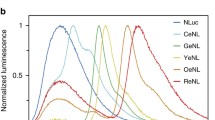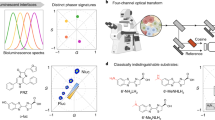Abstract
Chemical sensing, imaging and microscopy based on the use of fluorescent probes has so far been limited almost exclusively to the detection of a single parameter at a time. We present a scheme that can overcome this limitation by enabling optical sensing of two parameter simultaneously and even at identical excitation and emission wavelengths of two probes provided (a) their decay times are different enough to enable two time windows to be recorded, and (b) the emission of the shorter-lived probe decays to below the detectable limit while that of the other still can be measured. We refer to this new scheme as the dual lifetime determination (DLD) method and show that it can be widely varied by appropriate choice of probes and experimental settings. DLD is demonstrated to work by sensing oxygen and temperature independently from each other by making use of two probes, one for oxygen (a platinum porphyrin dissolved in polystyrene), and one for temperature [a europium complex dissolved in poly(vinyl methylketone)]. DLD was applied to monitor the consumption of oxygen in the glucose oxidase-catalyzed oxidation of glucose at varying temperatures. The scheme is expected to have further applications in cellular assays and biophysical imaging.

Principle behind the dual lifetime determination (DLD) method










Similar content being viewed by others
References
McDonagh C, Burke CS, MacCraith BD (2008) Chem Rev 108:400–422
Eggins BR (2002) Chemical sensors and biosensors. Wiley, Chichester
Wolfbeis OS (2008) Anal Chem 80:4269–4283 and previous biannual reviews
Borisov SM, Wolfbeis OS (2008) Chem Rev 108:423–461
Wallrabe H, Periasamy A (2005) Curr Opin Biotechnol 16:19–27
Colyer RA, Lee C, Gratton E (2008) Microsc Res Tech 71:201–213
Zheng Q, Xu G, Prasad PN (2008) Chem Eur J 14:5812–5819
Bonnist EY, Jones AC (2008) Chem Phys Chem 8:1121–1129
Zhang J, Campbell RE, Ting AY, Tsien RY (2002) Nat Rev Mol Cell Biol 3:906–918
Wolfbeis OS (ed) (2008) Fluorescence methods and applications: spectroscopy, imaging and probes. Ann NY Acad Sci 1430:1–388
Zheng Q, Xu G, Prasad PN (2008) Chem Eur J 14:5812–5819
Zhang L, Clark RJ, Zhu L (2008) Chem Eur J 14:2894–2903
Chen X, Wang X, Wang S, Shi W, Wang K, Ma H (2008) Chem Eur J 14:4719–4724
Valeur B (2002) Molecular fluorescence: principles and applications. Wiley-VCH, Weinheim
Uchiyama S, Iwai K, de Silva AP (2008) Angew Chem Int Ed 47:4667–4669
Coyle LM, Gouterman M (1999) Sens Actuators B61:92–99
Koese ME, Omar A, Virgin CA, Carroll BF, Schanze KS (2005) Langmuir 21:9110–9120
Borisov SM, Krause C, Arain S, Wolfbeis OS (2006) Adv Mat 18:1511–1516
Schroeder CR, Neurauter G, Klimant I (2007) Microchim Acta 158:205–218
Nagl S, Wolfbeis OS (2007) Analyst 132:507–511
Woods RJ, Scypinski S, Love LJC, Ashworth HA (1984) Anal Chem 56:1395–1400
Sharman KK, Periasamy A, Ashworth H, Demas JN, Snow NH (1999) Anal Chem 71:947–952
Ballew RM, Demas JN (1989) Anal Chem 61:30–33
Wu Z, Lin M, Schaeferling M, Duerkop A, Wolfbeis OS (2005) Anal Biochem 340:66–73
Schaeferling M, Wu M, Enderlein J, Bauer H, Wolfbeis OS (2003) Appl Spectrosc 57:1386–1392
Moore C, Chan SP, Demas JN, DeGraff BA (2004) Appl Spectrosc 58:603–607
Hradil J, Davis C, Mongey K, McDonagh C, MacCraith BD (2002) Meas Sci Technol 13:1552–1557
Stich MIJ, Nagl S, Wolfbeis OS, Henne U, Schaeferling M (2008) Adv Funct Mater 18:1399–1406
Yang C, Fu LM, Wang Y, Zhang JP, Wong WT, Ai XC, Qiao YF, Zou BS, Gui LL (2004) Angew Chem Int Ed 43:5009–5013
Borisov SM, Wolfbeis OS (2006) Anal Chem 78:5094–5101
Nagl S, Baleizão C, Borisov SM, Schaeferling M, Berberan-Santos MN, Wolfbeis OS (2007) Angew Chem Int Ed 46:2317–2319
Richardson FS (1982) Chem Rev 82:541–552
Reifernberger JG, Ge P, Selvin PR (2005) Rev Fluoresc 23:99–431
Hemmilae I, Laitala V (2005) J Fluoresc 15:529–542
Lee S, Okura I (1997) Anal Comm 34:185–188
Bizzarri A Koehler H, Cajlakovic M, Pasic A, Schaupp L, Klimant I, Ribitsch V (2006) Anal Chim Acta 573–574:48–56
Amao Y (2003) Microchim Acta 143:1–12 (review)
Choi MMF (2004) Microchim Acta 148:107–132 (review)
Liebsch G, Klimant I, Wolfbeis OS (1999) Adv Mater 11:1296–1299
Author information
Authors and Affiliations
Corresponding author
Rights and permissions
About this article
Cite this article
Nagl, S., Stich, M.I.J., Schäferling, M. et al. Method for simultaneous luminescence sensing of two species using optical probes of different decay time, and its application to an enzymatic reaction at varying temperature. Anal Bioanal Chem 393, 1199–1207 (2009). https://doi.org/10.1007/s00216-008-2467-0
Received:
Revised:
Accepted:
Published:
Issue Date:
DOI: https://doi.org/10.1007/s00216-008-2467-0




